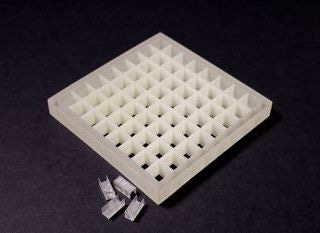Feb 28 2017
 Metamaterial bricks are assembled into a layer to produce a meta-surface, which could have applications across healthcare and entertainment. Credit: University of Sussex
Metamaterial bricks are assembled into a layer to produce a meta-surface, which could have applications across healthcare and entertainment. Credit: University of Sussex
Scientists have developed a super-material with the ability to bend, shape and focus sound waves passing through it.
The invention expands the boundaries of metamaterials, which belong to a new type of intricately engineered surfaces with the potential to execute nature-defying tasks.
Such materials have already produced exceptional results in light manipulation, thus enabling researchers, for instance, to develop a real-time version of the invisibility cloak worn by Harry Potter.
Researchers from the Universities of Sussex and Bristol have demonstrated that these materials can also be used with sound waves, a finding which can revolutionize the fields of personal audio and medical imaging.
Finely shaped sound fields find their use in a broad array of consumer products (e.g. ultrasonic haptics and audio spotlights) and also in medical imaging and therapy. The outcomes of the research have been published in the journal Nature Communications on Monday, 27 February 2017. This research demonstrates a simple and inexpensive technique for developing shaped sound waves by making use of acoustic metamaterials.
The researchers used numerous small bricks to fabricate a metamaterial layer, where each brick coils up space. The space coiling bricks work in a way to slow down the sound, that is, the incoming sound waves can now be transformed into a desired sound field.
The innovative metamaterial layers can be applied to many areas. Larger versions of these materials can be used to focus or direct sound toward a specific location to create an audio hotspot. Considerably smaller versions of the materials can be used to focus a high-intensity ultrasound to eliminate tumors deep in the body.
In such cases, a tailor-made metamaterial layer can be developed to fit a patient’s body and can be tuned to focus ultrasound waves at a desired site. In larger as well as the smaller versions, the layer can be affixed to prevalent loudspeaker technology and can be made in a swift and inexpensive manner.
Our metamaterial bricks can be 3D printed and then assembled together to form any sound field you can imagine. We also showed how this can be achieved with only a small number of different bricks. You can think of a box of our metamaterial bricks as a do-it-yourself acoustics kit.
Dr Gianluca Memoli from the Interact Lab at the University of Sussex
Professor Sriram Subramanian, who is the Head of the Interact Lab, further added that “We want to create acoustic devices that manipulate sound with the same ease and flexibility with which LCDs and projectors do to light. Our research opens the door to new acoustic devices combining diffraction, scattering and refraction, and enables the future development of fully digital spatial sound modulators, which can be controlled in real time with minimal resources.”
In the future I think there will be many exciting applications of this technology. We are now working on making the metamaterial layers dynamically reconfigurable. This will mean we can make cheap imaging systems which could be used either for medical diagnostics or crack detection.
Bruce Drinkwater, Professor of Ultrasonics at the University of Bristol
Metamaterial bricks and quantization of meta-surfaces
Interact Lab/Youtube.com